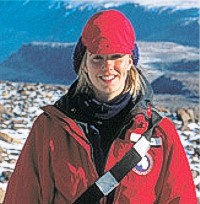Jane Willenbring

BSc (Geosciences), North Dakota State University, 1999
MA (Earth Sciences) Boston University, 2002
Ph. D. Thesis
Grain-Size Analysis for Paleocurrent Intensity Reocnstruction during Late Quaternary in the Eastern Equatorial Pacific
(PDF - 9.6 Mb)
Landscapes of northern Canada are often associated with subglacial erosion during the Quaternary glaciations; however, the rates and spatial pattern of subglacial erosion are unknown. Terrestrial in situ cosmogenic nuclides (TCN) extracted from glaciated bedrock and till provide a new method to identify paleo-glacier basal thermal conditions. Differential preservation of pre-glacially produced TCN reflects the degree of glacial erosion. In warm-based zones, subglacial erosion stripped the upper few metres of regolith and bedrock and effectively removed the pre-glacial TCN. In cold-based subglacial conditions, the ice was frozen to the bed and the inherited TCN concentration survived.
Measurements of TCN concentrations from bedrock indicate that the valleys were eroded > 2.5 metres during a glacial-interglacial cycle. On summit plateaus, however, the long-term erosion rate is < 1.4 m/Ma. The juxtaposition of erosive ice in valleys and non-erosive ice atop interfluve plateaus has generated relief in arctic and sub-arctic regions.
Tills with monolithologic, angular clasts associated with cold-based ice contain 2-50 times the TCN concentration of silt-rich tills with polylithologic, striated clasts associated with warm-based ice. Measurement of minimum ice burial durations of >3 Ma suggest that recently deglaciated surfaces near modern ice caps may have been covered by cold-based ice since Pliocene time. Identifying cold-based anomalies in basal sliding is an obstacle to interpreting glacial dispersal patterns for mineral exploration.
Glacial erosion and till production are inferred to be functions of the thermal regime at the base of glacier ice and are tested by linking the distribution of TCN in bedrock and till with modelled basal thermal conditions using the University of Maine Ice Sheet Model (UMISM). TCN-derived glacial erosion rates vary linearly with modelled average sliding velocity by a glacial erosion coefficient of 5x10-7 - three orders of magnitude lower than in other regions.
Quaternary ice sheets and the driving global cooling during glaciations cause synoptic atmospheric pressure fluctuations from katabatic winds and atmospheric compression. Modelled atmospheric pressure changes due to presence of global ice sheets produces up to a 10% difference in TCN production rates for samples exposed near ice sheets and at high elevations during glaciations when compared to present-day production rates.
Keywords:
Pages: 261
Supervisor: John Gosse



